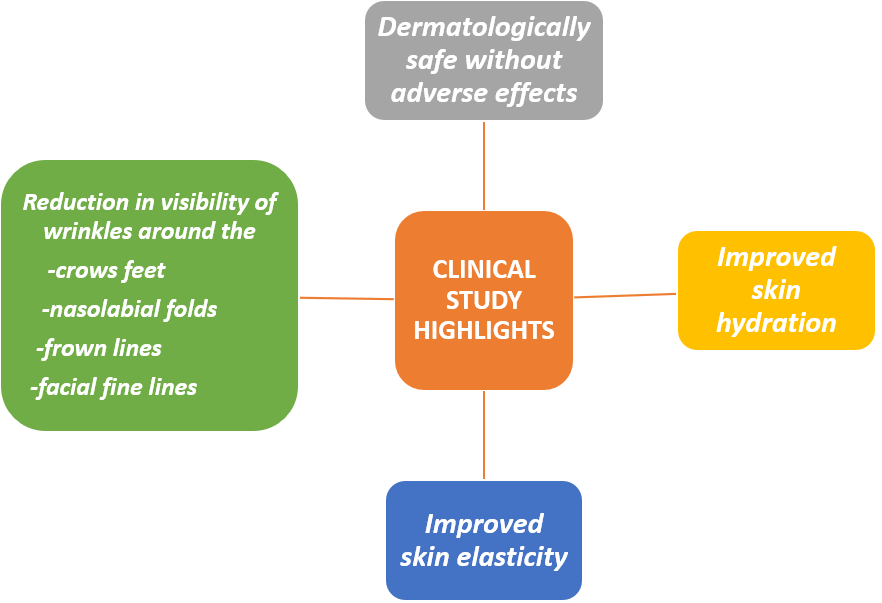A Randomized Double-Blind, Placebo-Controlled Study to Evaluate the Anti-Skin-Aging Effect of LactoSporin® – The Extracellular Metabolite from Bacillus coagulans (Weizmannia coagulans) MTCC 5856 in Healthy Female Volunteers
Clin Cosmet Investig Dermatol. 2023; 16: 769–782
Objective and Study Design
The anti-skin-aging potential of LactoSporin® was evaluated in a randomized, double-blind, placebo-controlled, monocentric study in 56 healthy female volunteers of the age group 35 to 65 yrs. The volunteers applied either 2% LactoSporin® cream or a placebo for 10 weeks.
Results
Dermatological Assessment
Instrumental Assessment by Antera 3D
The wrinkles on the forehead, forehead texture, crow’s feet, nasolabial folds, and under-eye fine lines showed improvement in LactoSporin® group compared to placebo.
Self-Assessment Questionnaire
The use of LactoSporin® cream for 10 weeks made the skin firmer, improved the fine lines and wrinkles, and keeps the skin moisturized, compared to placebo groups.
Safety Assessments
No adverse events or skin irritations were observed in any of the volunteers during the study.
Conclusion
The clinical study showed that the use of LactoSporin® could be a safe and effective natural antiaging ingredient in cosmetic formulations to reduce wrinkles and fine lines.

Continue reading: doi: 10.2147/CCID.S403418
Novel topical application of a postbiotic, LactoSporin®, in mild to moderate acne: A randomized, comparative clinical study to evaluate its efficacy, tolerability and safety
Cosmetics 2020; 7(3): 70
“Acne is the most common exasperating skin condition in teenagers and young adults, causing emotional distress. It is characterized by excessive sebum production, inflammation, keratinization of follicles, and overgrowth of the bacteria Cutibacterium acnes. Conventional agents like antibiotics, benzoyl peroxide, and retinol can cause antibiotic resistance, skin barrier disruption, leading to dryness and irritation. New treatment options targeting multiple pathologies by calming inflammation, maintaining skin moisture and barrier function along with preserving the skin microbiome with minimal side effects are essential for treating acne. Natural products have been the focus of skin care due to their efficacy and safety profile. Extracellular metabolites from probiotics, also termed as “Postbiotic,” can influence the microbiome composition of the skin. LactoSporin® acts as an antimicrobial agent by lowering the pH, inhibiting microbial biofilms, and draining the ions from the targeted cells.”
Objective
To compare the efficacy of LactoSporin® 2%w/w cream with Benzoyl peroxide in subjects with mild-to-moderate acne.
Study design
The study was open-label, randomized monocentric study in 64 male and female subjects with mild-to-moderate acne for three weeks.
- The mechanism of action and properties of LactoSporin®, the pH stability, thermostability, antimicrobial activity and 5-alpha reductase activity were evaluated by in vitro method
- The efficacy parameters were evaluated based on the dermatologist visual assessment and instrumental measurements using Sebumeter® MPA580, Antera 3D™ and VISIA CR 2.2 and subject self-assessment questionnaires
- Adverse events were recorded throughout the study period
Results and discussion
- LactoSporin® was stable at an acidic pH and temperature range of 70 to 90 °C, with antimicrobial activity against various pathogenic bacteria, including Cutibacterium acnes
- It was also a potent inhibitor of 5-alpha reductase activity
- A significant improvement was observed in the dermatological assessment of closed comedones (p < 0.0001), open comedones (p = 0.0069) and papules count (p < 0.0001) in comparison to the baseline in both LactoSporin® and benzoyl peroxide groups
- The antera analysis showed significant improvement in redness (p < 0.0001) and elevation (p < 0.0001) (small and medium) in both the treatment groups
- The sebumeter analysis showed a significant decrease in sebaceous secretion (p < 0.0001) for LactoSporin®, which resulted in reduced oiliness, pimples, acne spots and redness around the acne spot
- The product was found to be safe without any irritancy
Conclusion
LactoSporin® 2%w/w cream was a safe anti-acne formulation with efficacy comparable to the standard treatment of benzoyl peroxide 2.5% gel. Considering the clinical efficacy, continuous treatment and patient satisfaction, LactoSporin® is highly suitable for treating subjects with mild-to-moderate acne vulgaris.
Continue reading: https://doi.org/10.3390/cosmetics7030070
